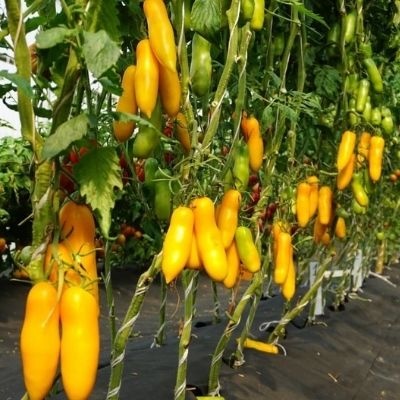
- Category: hybrid
- Growth type: semi-determinant
- Appointment: fresh consumption, for whole-fruit preservation, for curing and drying
- Ripening period: mid-season
- Ripening time, days: 105-110
- Growing conditions: for open ground, for greenhouses
- Bush size: tall
- Bush height, cm: up to 180
- Ripe fruit color: yellow
- Fruit shape: banana
Siberian bananas are a semi-determinant tomato hybrid obtained by Russian breeders. The unique appearance of the fruit attracts the attention of gardeners. Tomatoes have a universal purpose, they can be used for drying, drying, preservation or fresh.
Description of the variety
Siberian bananas form tall bushes up to 180 cm. Side shoots are formed moderately. The first inflorescence is laid above 6-8 leaves. The foliage is intense, the tops are green, prone to thickening.
The main qualities of the fruit
Bright yellow tomatoes with smooth skin and dense flesh look very unusual. Tomatoes are large, banana-shaped, weighing up to 150-180 g. They are collected in a bunch of up to 9 pieces each. The elongated fruit is up to 15 cm long.
Taste characteristics
Fruits with dessert sweet pulp are very tasty fresh. The tomato receives a high tasting rating from amateurs and professionals. The aroma is classic, tomato. According to the ratio of sugar content and acidity in taste, it is considered to be well balanced.
Ripening and fruiting
The Siberian banana tomato is mid-season. The average ripening period is 105-110 days.
Yield
From 1 sq. m harvested up to 15 kg of tomatoes. The hybrid is considered a high-yielding hybrid.
The timing of planting seedlings and planting in the ground
Tomatoes are grown in seedlings. The seeds are sent to the soil in mid-March. Plants are transferred to the greenhouse when the average air temperature reaches +15 degrees.

Growing tomato seedlings is an extremely important process, because it largely depends on whether the gardener will be able to harvest at all. All aspects must be taken into account, from seedbed preparation to planting in the ground.
Landing scheme
Tomatoes of this hybrid are not planted too tightly. It is recommended to maintain a density of about 3 plants per 1 m2.

Growing and care
Siberian bananas are a tall hybrid that responds well to standard agrotechnical measures. He is recommended to land in a sunny, well-lit place. The soil should be rich in organic matter and minerals. Bushes consume them intensively during the period of fruiting and climb. It is important that when grown in greenhouses, plants receive sufficient ventilation, sometimes even additional ventilation is required.
The tomato is responsive to good care. Plants are sensitive to watering. Moisture is applied abundantly, especially in greenhouses. Watering frequency is 1-2 times a week.As a fertilizer, infusion of mullein is best suited, which is applied alternating with mineral complexes.
Bushes should be regularly pinned - side shoots under the lower flower brush are removed. For 1 treatment, no more than 3 processes are removed. In addition to pinching, the tomato requires formation - 2-3 stalks in the greenhouse, 1-2 in the open field. Tall shoots are tied to trellises or stakes. Fruit clusters are strengthened with props to avoid kinking.




A plant needs different micronutrients at each stage of growth. All fertilizers can be divided into two groups: mineral and organic. Folk remedies are often used: iodine, yeast, bird droppings, eggshells.
It is important to observe the rate and period of feeding. This also applies to folk remedies and organic fertilizers.
Disease and pest resistance
The tomato is resistant to most diseases of nightshade crops. Not affected by late blight. Siberian bananas actively attract pests. Bushes must be protected from them with chemical insecticides. Colorado potato beetles, if they appear, are harvested by hand.


Resistant to adverse weather conditions
Plants tolerate fluctuations in daytime temperatures well. Adapted for growing in regions with short summers. In case of drought, they quickly restore the former elasticity of shoots and leaves after the restoration of irrigation.
Review overview
According to summer residents, Siberian bananas stand out not only for their large size and unusual shape, but also for their exceptional taste among the tomatoes with a golden-yellow color. Summer residents also note the excellent germination of plants - above average, the ease of growing them. Tomato bushes do not require special attention during the growing season. Yield problems do not arise even in the open field.
To the pluses, amateurs of vegetable growers also include the unusual color of the fruits.They are neon yellow, very bright, complemented by a golden tint when fully ripe. According to reviews, these tomatoes are hypoallergenic - due to the lack of red pigment, they are perfect for baby food, pizza making, and decorating dishes.
Among the problems that arise when growing tomatoes of this hybrid, summer residents note the difficulties with preserving the ovaries. They are prone to shedding, drying out if irrigation is not properly regulated.

























































































